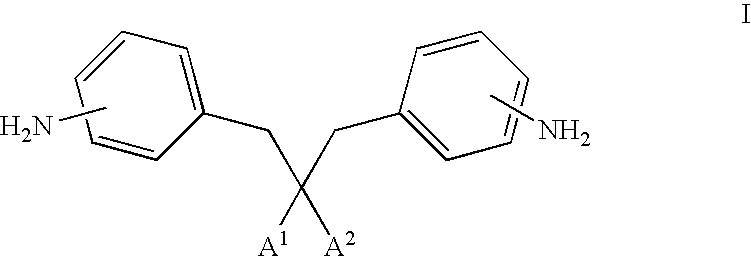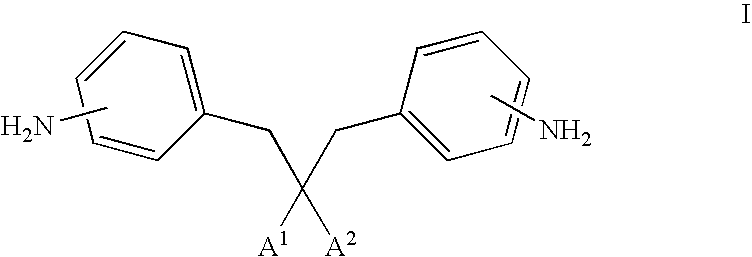Photoactive materials
a technology of photoactive materials and diamine compounds, applied in the field of new diamine compounds, can solve the problems of dust generation, scratching due to brushing, and destruction of thin film transistors, and achieve the effects of reducing or possibly suppressing degradation, improving light stability, and low light absorption
- Summary
- Abstract
- Description
- Claims
- Application Information
AI Technical Summary
Benefits of technology
Problems solved by technology
Method used
Image
Examples
synthesis example 1
[0141]Bis[6-({4-[(1E)-3-methoxy-3-oxoprop-1-enyl]benzoyl}oxy)hexyl]2,2-bis(aminobenzyl)malonate was prepared in accordance with the following procedure.
Preparation of bis[6-({4-[(1E)-3-methoxy-3-oxoprop-1-enyl]benzoyl}oxy)hexyl]malonate
[0142]
[0143]5.00 g (16.32 mmol) 6-hydroxyhexyl 4-[(1E)-3-methoxy-3-oxoprop-1-enyl]benzoate, 1.02 g (9.80 mmol) malonic acid ester and 0.50 g (4.09 mmol) 4-dimethylaminopyridine were dissolved in 150 ml of dichloromethane. A suspension of 3.75 g (19.56 mmol) N-(3-dimethylaminopropyl)-N′-ethylcarbodiimide hydrochloride and 100 ml dichloromethane were added dropwise in the course of 40 minutes. After 22 hours at room temperature the reaction mixture was partitioned between dichloromethane and water; the organic phase was washed repeatedly with water, dried over sodium sulfate, filtered and concentrated by rotary evaporation. Chromatography of the residue on 110 g silica gel using toluene:ethyl acetate(9:1) then (1:1) as eluant yielded 2.14 g (39%) bis[6-...
synthesis example 2
[0155][6-({4-[(1E)-3-methoxy-3-oxoprop-1-enyl]benzoyl}oxy)hexyl]2-(4-nitrobenzyl)-3-(4-nitrophenyl) propanoate was prepared in accordance with the following procedure.
Preparation of 2,2-dimethyl-5,5-bis(4-nitrobenzyl)-1,3-dioxane-4,6-dione
[0156]
[0157]15.0 g (69.4 mmol) of 4-nitrobenzylbromide and 5.00 g (34.7 mmol) of Meldrum's acid were dissolved in 100 ml 2-butanone. 4.40 g (104.1 mmol) potassium carbonate were added, the resulting suspension was heated to 50° C. and allowed to react for 2.5 hours. After cooling to room temperature, 100 ml water were added. The product was collected by filtration and washed with a lot of water. 12.3 g (85%) of 2,2-dimethyl-5,5-bis(4-nitrobenzyl)-1,3-dioxane-4,6-dione as yellowish powder was used without further purification.
Preparation of 2,2-bis(4-nitrobenzyl)malonic acid
[0158]
[0159]2.185 g (52.07 mmol) of lithium hydroxide were added to a suspension of 10.79 g (26.04 mmol) of 2,2-dimethyl-5,5-bis(4-nitrobenzyl)-1,3-dioxane-4,6-dione and 110 ml m...
synthesis example 3
[0166]Cholest-5-en-3-yl 2-(4-aminobenzyl)-3-(4-aminophenyl)propanoate was prepared in accordance with the following procedure.
Preparation of cholest-5-en-3-yl 2-(4-nitrobenzyl)-3-(4-nitrophenyl)propanoate
[0167]
[0168]2.00 g (5.34 mmol) of 2,2-bis(4-nitrobenzyl)malonic acid and 2.07 g (5.35 mmol) 5-cholesten-3β-ol and 65 mg (0.53 mmol) 4-dimethylaminopyridine in 40 ml of dichloromethane were cooled to 0° C. and 1.16 g (5.62 mmol) N,N′-dicyclohexylcarbodiimde were added. The mixture was subsequently allowed to react for 2 hours at 0° C. and 19 hours at 25° C., filtered and concentrated by rotary evaporation. Chromatography of the residue on 50 g silica gel using toluene as eluant and recrystallisation form ethyl acetate yielded 3.09 g (83%) Cholest-5-en-3-yl 2-(4-nitrobenzyl)-3-(4-nitrophenyl)propanoate as a white powder.
Preparation of Cholest-5-en-3-yl 2-(4-aminobenzyl)-3-(4-aminophenyl)propanoate
[0169]
[0170]2.62 g (3.75 mmol) Cholest-5-en-3-yl 2-(4-nitrobenzyl)-3-(4-nitrophenyl)propa...
PUM
| Property | Measurement | Unit |
|---|---|---|
| thickness | aaaaa | aaaaa |
| wavelengths | aaaaa | aaaaa |
| temperature | aaaaa | aaaaa |
Abstract
Description
Claims
Application Information
 Login to View More
Login to View More - R&D
- Intellectual Property
- Life Sciences
- Materials
- Tech Scout
- Unparalleled Data Quality
- Higher Quality Content
- 60% Fewer Hallucinations
Browse by: Latest US Patents, China's latest patents, Technical Efficacy Thesaurus, Application Domain, Technology Topic, Popular Technical Reports.
© 2025 PatSnap. All rights reserved.Legal|Privacy policy|Modern Slavery Act Transparency Statement|Sitemap|About US| Contact US: help@patsnap.com



